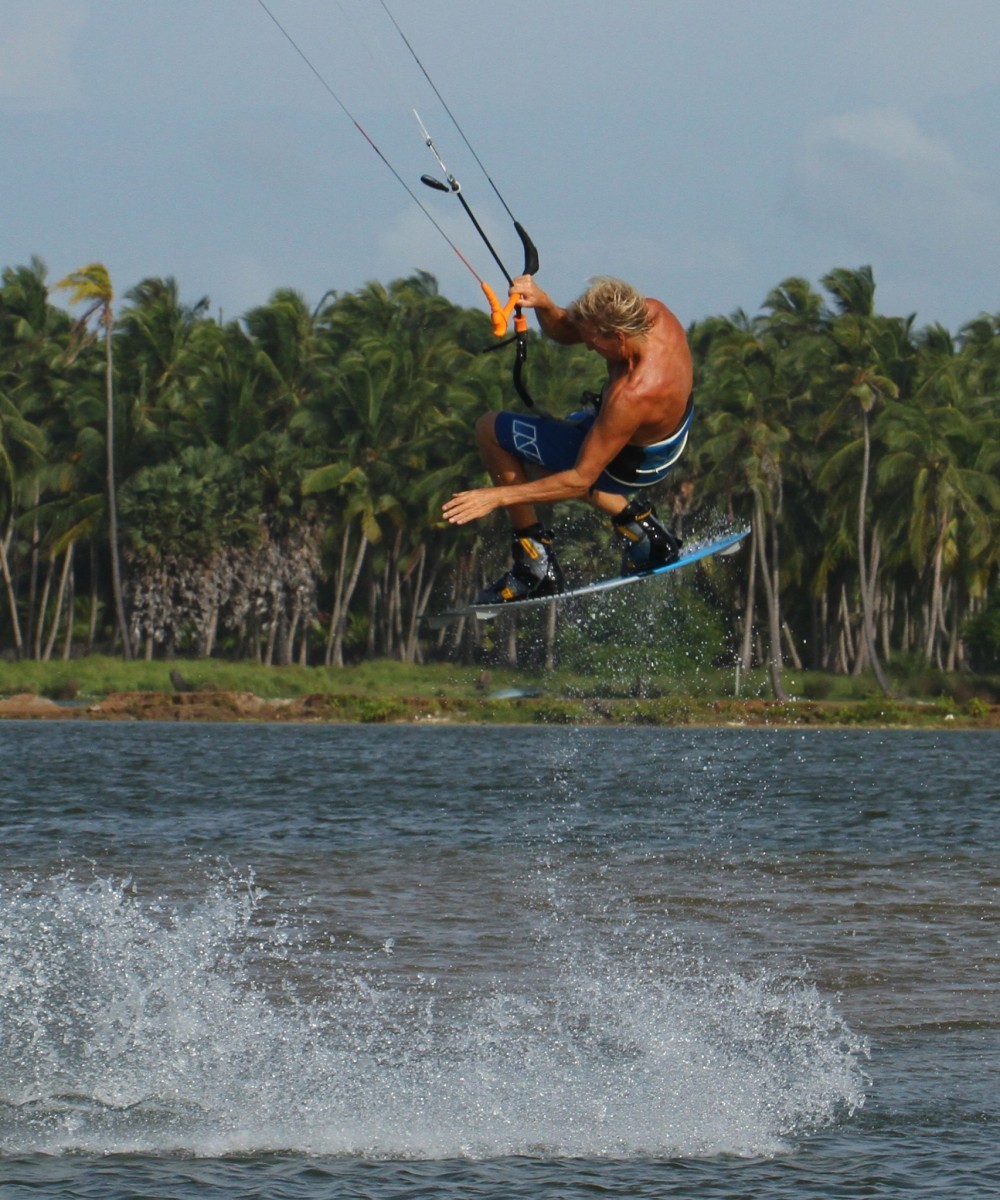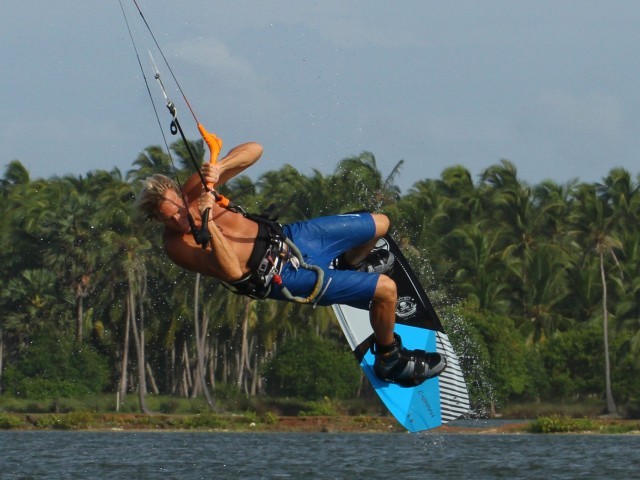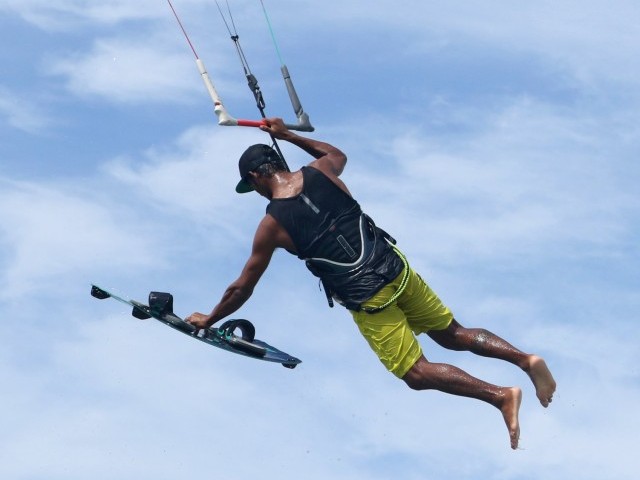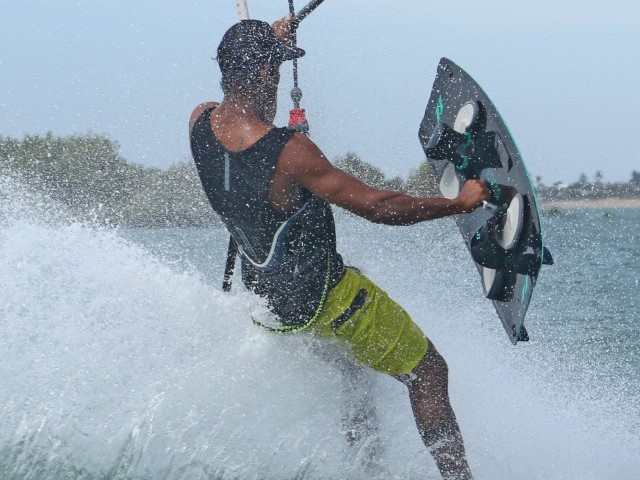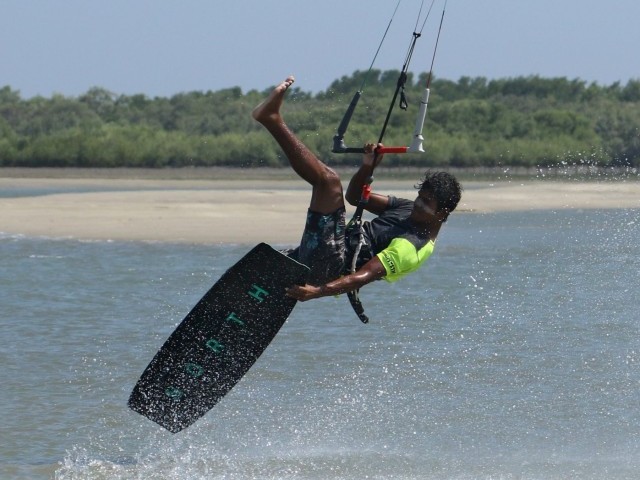
Unhooked Popped Front Nose Grab to Toeside
Technique / Advanced
Introduction
Final trick this issue brings us back to some fanciful unhooking with this nose grab popped front to toe side. This is a fun move, which leads on to further tricks, and that can reward you with a decent photo. You’ll be grabbing the nose of the board with your front hand, so it should be reachable! This grab goes well with the toe side landing as it helps you slow the rotation. Other than actually getting the grab your challenge here will be popping hard enough and in the correct position so that you can release your front hand from the bar without your kite going up during the move!
Needless to say, this will be a lot simpler to learn if you can already pop a front, unhooked preferably! However, we’ll concentrate on all the key moments - if you’re keen let’s give it a crack.
Aggression Pic A
We must have written and said this a thousand times: that the approach and pop go hand in hand. You have to get the planets aligned and then you’ll get good pop. This requires concentration, focus and grunt. Coming into this like every other pop trick requires a shift in weight, moving your hips back over or even behind the back strap/boot. This way you’ll be riding on the back of the board, and the tail with its rocker will help you get some pop. To further increase your chances, you’ll need to bear away a bit off the wind, so that you can carve up without stopping, and so that the kite drops back in the window (more downwind of you) which will give you something to pop against and help you land downwind. If you do this with your arms in and your shoulders back, you should be able to get some decent pop.
Here Christian has ticked the aforementioned boxes, his sweet spot is trimmed in close, he’s unhookedand with his kite around 11 o’clock, and with his hands either centred on the bar, or his back hand straddling the centre line, he’s now carving up hard. From his approach position he only needs to turn his head and shoulders and he’ll end up nice and low straining his lines, with a solid carve and enough flex in his back leg from which to explode. His arms are bent and he is grimacing as it’s taking some effort.
Up & Over Pic B
For the popped front you must stamp away against the edge of your board. If you throw yourself across it you won’t get the height. Even though you want and need to rotate you have to get the up first. As you kick against the board and it throws you up the bar will become lighter (if the kite hasn’t moved up) and as a result you’ll be able to get your elbows in and hands close whilst the kite will lift with you. This gives you the fulcrum point of the rotation, as in theory you’ll be going up and over your hands. In the photo you can see that Christian has kicked hard against the board, fully extending his back leg, forcing himself upwind of the board which springs him up off the water. He’s pulling his hands in close and lifting his front knee high ready for the rotation. His chin is tucked under but he hasn’t turned his head yet as that comes a split second later once he knows he’s up.
Release and Rotate Pic C
Once you’re up it’s time to get the rotation going and get the grab in. If you leave it too long you’ll miss the moment. As Christian already has his front knee high and hands in he can use the momentum from his pop to start rotating by dropping his front shoulder. By lifting his back leg he’s making himself small, so he’ll rotate easily and he won’t drop away from the bar, which will steer the kite up. With both knees up and the front roll initiated he can release his front hand and look at the nose of the board where he intends to grab.
Your Money Shot Pic D
Once you’ve got the grab you can worry about getting around and setting yourself up for the landing. You can see how Christian’s legs have come up and over so that the board is high. This really comes from the aggressive pop along with keeping the arms in close and lifting that front knee as you pop off. Due to this position Christian isn’t, and you won’t be, dangling underneath the bar, which would cause the kite to steer up and pull away from you. Now that Christian has the grab he looks over his shoulder so that he can see where he’s going. He keeps that back arm bent whilst holding the kite, which keeps his legs high as he comes around. If you’ve popped up hard this doesn’t require strength.
The Drop Pic E
If you kicked up hard and didn’t turn your head until you grabbed, your rotation will be slow, in fact it will almost stall, which handily leads to a toe side landing. However, it’s important that you look where you are going as gravity will take over pretty quickly and pull your board and legs down. As soon as you feel them dropping it’s time to get your front hand on the bar so that you can keep it in close and keep the kite down. Christian’s feet are dropping so he’s got both hands back on the bar and is keeping it in close. By having the bar in close his feet will drop down under the bar. If you let the bar out, your feet and board will be left behind and you’re more likely to fall when the board touches the water as your body weight will be leading rather than over the board.
Touch Down Pic F
With your arms in, your body weight will fall onto the board. You will land heel heavy therefore keep your head over the bar so that you can flatten the board off and continue toe side rather than having to carve back around. Christian is also pulling down on his front (left) hand to make sure that the kite leads him forwards, whilst he absorbs the impact with his legs.
Top Tips
This one really is about the pop, so start off with a few hefty fronts with no thought of a grab. Concentrate on keeping the arms in and getting that up and over sensation. If you do this, you’ll find that you have plenty of time to add that cheeky grab.
Power here is also crucial. If you’re underpowered you’ll find it difficult to pop hard enough to get up and over. However, if you’re stacked and can’t trim your sweet spot low enough your kite won’t fly happily and you won’t be confident, so pick the right moment.
Now visualise the move in its entirety by looking at the sequence and videos.
Common Problems
If your kite is lifting hard on take off and therefore pulling too much throughout the move, then, assuming that you’ve trimmed the kite correctly, you’re either not bearing away enough before unhooking, or carving up for too long before popping. It should be off the wind, unhook, turn and go. Don’t wait for something to happen - make it happen.
If you can’t reach the grab you’re most likely throwing yourself forward into the front roll too early. Pop up and bring the front knee up, front hand to nose of board shouldn’t be too much of a stretch.
If you’re crashing downwind of the board on landing, it means that you’re getting straightened out during the rotation, so keep compact, keep the arms in and get the front hand back on as soon as the board starts to drop.
Keystones
- Aggressive pop away from the board.
- Arms in close.
- Up first, then over.
- Grab, then turn your head.
- Front hand on as soon as the board starts to drop.
This technique article was in Issue 56 of IKSURFMAG.
Related
By Christian and Karine
Christian and Karine have been working together as a coaching team, running improver to advanced kitesurfing clinics since 2003.













